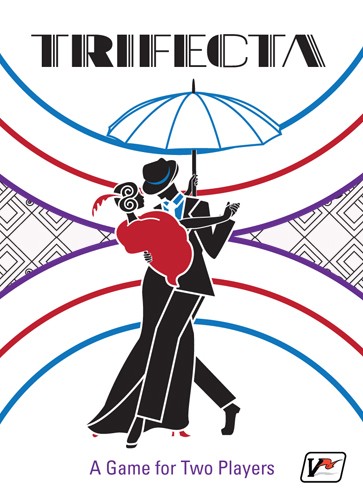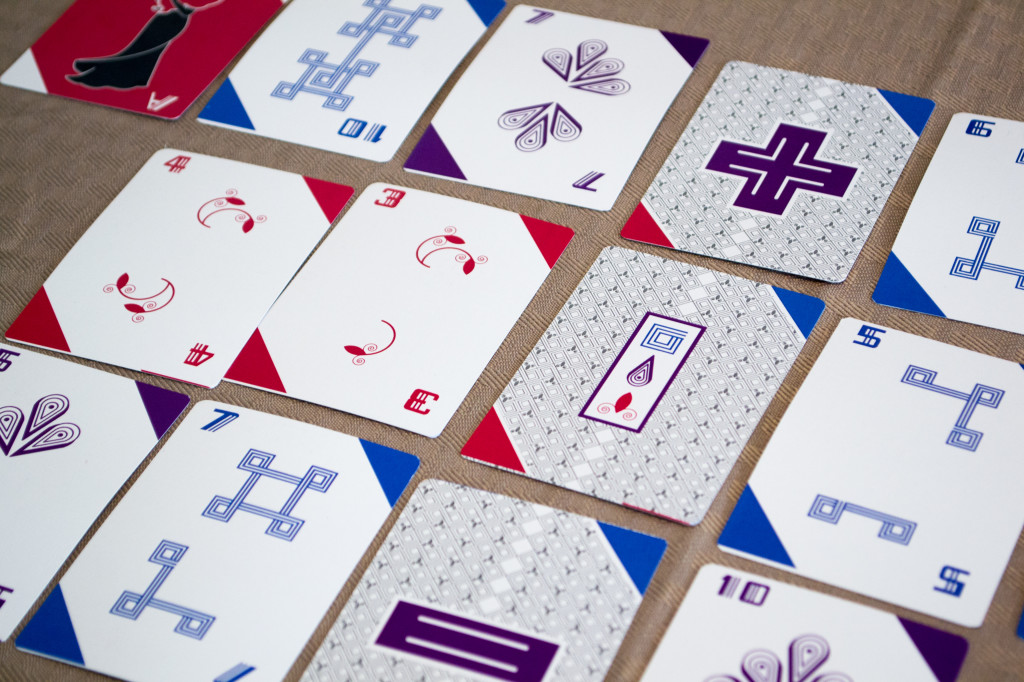If you’re concerned that this game is a horse racing betting simulator, you needn’t worry. “Trifecta” comes off as a more complex version of “Blackjack” (at least to me) in that you’ll be endeavoring to form rows with cards that total between twenty-one and twenty-six points. Each player will have their own grid with which to work and must obey specific rules that govern each row. Before I delve too deeply into that, I’d like to thank Karen Wolterman from Victory Point Games for reaching out and sending me a press copy.
Components
Cards – The game’s sole component is a deck of forty-five cards. The “plus”, “minus”, and “suit” cards are used for organizing the grid from which players will be working. The rest consist of typical playing cards that you’d expect to see in a regular deck (aces, kings, queens, jacks, number cards, etc.).
Setup & Gameplay
One “plus”, “minus”, and “suit” card are placed in a central vertical column between both players. One player will be assigned the imaginary grid to the left of the column while the other player will be assigned the imaginary grid to the right of the column. Each grid has three rows…the “plus” row, the “minus” row, and the “suit” row. The deck of cards is shuffled and each player receives two to form their starting hand. The player with the fanciest clothing goes first.
On a player’s turn, they’ll perform the following actions:
1) Draw a card from the deck. If the deck runs out, players will shuffle the discard pile to form a new deck.
2) Play a card from their hand onto either their grid or onto their opponent’s grid. The card can be placed in any of the three rows assuming that the placement rules are observed. A card placed on the “plus” row must be of equal or greater value than the card before it. Likewise, cards placed on the “minus” row must be of equal or lower value than the one before it. Cards on the “suit” row must be of the same suit, with the first card determining the suit. The card ranking is: 2, 3, 4, 5, 6, 7, 8, 9, 10, J, Q, K. Aces are wild in terms of suit and rank. Whenever a “two”/”king” is played, the “minus”/”plus” card is flipped to the other side, respectively.
It’s worth noting that instead of playing a card as explained in step two, you can opt to discard your entire hand and draw two new cards. When a row is filled with five cards, the player who owns that row will check to see if they score. The values of the row are added (Aces are 1 or 11, J/Q/K are 1) and if it totals between twenty-one and twenty-six points, they score a single point. The five cards in that row are then discarded, whether the player scored or not. The first player to three points, wins the game!
The above doesn’t cover all of the rules found in the manual, but should give you a general overview as to how the game is played. For more information, you can check out the rulebook here:
The Review
I couldn’t help but notice that the rulebook from which I was working (linked above) instructed players to place the plus/minus/suit card duplicates back into the box. That got me to thinking…why include them at all if you were never meant to use them? Having done a little homework, I discovered that the rules have changed a bit since the game first appeared on Kickstarter. Apparently, in the earlier versions of the rulebook, each player was assigned their own grid and had their own personal plus/minus/suit card column. Players also didn’t have a “hand”…they just simply drew a card and placed it where they felt like it (whilst observing the placement rules, of course).
My guess is that the rules were changed both based on critic/player feedback and to give the game more strategic flair. The addition of a “hand” certainly gives the player some more choices and I’m glad they (the developers) decided to include this new rule. With players using the same plus/minus/suit rows, there is also the possibility that flipping a “plus” to a “minus” and vice versa with the appropriate “king”/”two” card will mess up your opponent’s best laid plans. In my opinion, a separate vertical column for each player would potentially give players in a bit more control over their own grid. Now, in this newly reformed version, things are a tad more chaotic.
Along those lines, our play sessions were positive overall. I’ll admit that I probably wouldn’t have enjoyed the game based on the old rule set. Drawing one card and placing it doesn’t offer the player in question a lot of choice, despite the fact that you could place the card onto your opponent’s grid if you wanted to. Having a hand, at least, allows you to set up a combo or two with which to score. Alternatively, you could save a very high or low card and place it as your opponent’s fifth card, placing the row’s total outside the required number and robbing them of a point.
In the end, I’m forced to give it a passing grade and then some based on the fact that it’s simple to play yet still doesn’t feel like I’m mindlessly going through the motions. As such, I think it would be an ideal casual game for couples & parent/child pairings. With a little creativity, I’m sure you could expand the game to three or four players with the purchase of an extra deck (though I haven’t tried it myself). The artwork is pleasant to look at, though the price is a few bucks more than what I would have expected ($10.99 as of 8/12/14) for a deck of forty+ cards. Card games like “Phase 10” and “Uno”, for example, can be found on Amazon for about seven bucks (the prices vary). The instructions are also “part” of the box, making reassembly more difficulty than it needs to be. Still, “Trifecta” both surprised us and kept us actively engaged from start to finish.
Final Verdict: 7/10
—
You can learn more about and purchase “Trifecta” by visiting the following websites:
http://www.victorypointgames.com/trifecta.html
—


